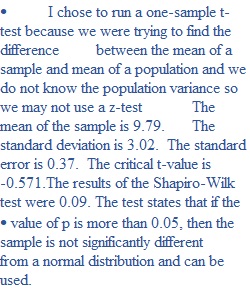


Q Name: Date: Open the dataset, “Baumann.sav”. The Baumann data frame has 66 rows and 6 columns. The data are from an experimental study conducted by Baumann and Jones, as reported by Moore and McCabe (1993). The participants were 31 second-graders with an instructional reading level that was approaching grade level. Students were randomly assigned to one of three experimental groups. This data frame contains the following columns: group: Experimental group; a factor with levels: Basal, traditional method of teaching; DRTA, an innovative method; Strat, another innovative method. pretest.1: First pretest. pretest.2: Second pretest. post.test.1: First post-test. post.test.2: Second post-test. post.test.3: Third post-test. For following questions you will be asked to conduct a hypothesis test analysis in JASP. You must decide whether the situation fits a one sample t-test, independent samples t-test or a paired-sample t-test. PART I (5 point): A researcher is not sure if the sample is representative of the entire population of the second-grade students in the US in terms of their First pretest scores (pretest.1 variable). Run a test to see if the sample in the dataset is representative of the population of the second-grade students in the US (µ = 10, please note this is not really the population mean, it was made up for the purpose of this assignment only!). Copy and paste the output into your assignment write-up document, state the descriptives of the sample (mean, standard deviation, standard error) as well as the critical t-value, and answer/complete the following: • What kind of t-test did you choose to run and why? • Describe the descriptives for the samples (mean, standard deviation, standard error) • One of the assumptions of t-tests is that the outcome variable distribution is approximately normal. Check this assumption using the Shapiro-Wilk test. o Interpret the results of the Shapiro-Wilk test and determine if it would have been better to conduct a non-parametric test (as an alternative to T-test) or not. • State the null and alternative hypothesis for the t-test you ran. • Write an APA style conclusion (~2 sentences) whether the test was significant, and include the t-statistic that was calculated, df, p-level, and 95% confidence interval. PART II (5 points): Perform the hypothesis tests for the Strat group for the pre-test/post-test variables pretest.2 and post.test.2 using the “Baumann Part 2.sav” dataset. Copy and paste your output into your word document, state the descriptives of the two samples for both variables (mean, standard deviation, standard error), and then answer the following: • What kind of t-test did you choose to run and why? • Describe the descriptives for the samples (means, standard deviations, standard error) • State the null and alternative hypotheses. • Write an APA style conclusion (~2 sentences) whether the mean difference was significant, and include the t-statistic that was calculated, df, p-level, and 95% confidence interval PART III (5 points): Conduct a hypothesis test for the DRTA vs.Strat group for the post-test variable post.test.3 using the “Baumann Part 3.sav” dataset. Copy and paste the output from this test into your document, and answer the following: • What kind of t-test did you choose to run? Why? • State the means of each group for post.test.3 and their respective standard deviations and standard errors as well as the mean difference. • State the null and alternative hypothesis. • According to Levene’s test for Equality of Variances – can you assume the the DRTA vs.Strat group have equal variances for the post.test.3 scores? Explain why or why not. • Write an APA style conclusion including the t-statistic, df, and 95% confidence interval.
View Related Questions